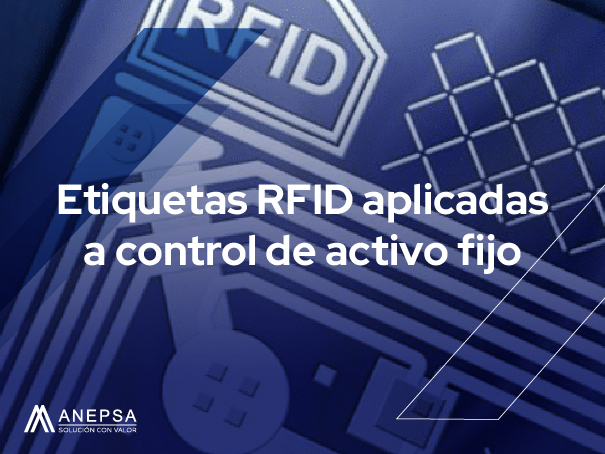RFID tags applied to fixed asset control in hotels

content structure
What are RFID tags?
In the case of companies with an extensive inventory of fixed assets, It is essential to recognize the need to label these elements with plates or labels identification, which enable access to detailed information about each asset and its current condition, an example of these solutions are RFID tags, created by M.I.T. In the 1920s, these tags used radio frequency technology to identify objects and assets, allowing for remote storage and retrieval of data.
How does the RFID system work?
Through the emission of radio frequency signals emitted by the tags, these are detected by an RFID reader, this device receives information and transforms it into a digital format, it is made up of 3 important elements that allow it to be operated correctly:
-
- RFID LABELS: The tags consist of an antenna, a transducer and a chip that incorporates a memory capable of transmitting information, which is captured by the antenna.
In read-only mode, it is possible to assign a unique and personalized code to identify assets or objects, on the other hand, in read and write mode, these tags allow both reading and modifying data.
In terms of anti-collision, these tags make it possible for readers to identify multiple tags simultaneously, as long as the tags are entered one by one.
-
- RFID READER OR TRANSCEIVER: These elements consist of an antenna, a transceiver and a decoder, the objective is for the readers to emit signals regularly and detect if there is information transmitted by the tags, this information is sent to another system, where the processing and data analysis.
-
- DATA PROCESSING SUBSYSTEM: This point is where the information acquired from the labels is processed and saved.
Type of fixed assets in hotels
Fixed assets in hotels are those tangible or intangible resources that the hotel company acquires and uses in its long-term operations., these assets are intended to be used in the generation of income over an extended period of time and are not expected to be converted into cash immediately, some examples of fixed assets in hotels are:
Buildings and Structures: It includes the main hotel building, recreation facilities, common areas and any other physical structures that are part of the hotel complex.
Land: The land on which the hotel is located is also considered fixed assets, as they are essential to its operation and value.
Furniture and Equipment: Beds, tables, chairs, sofas, televisions, appliances and other items used in rooms and common areas.
Cooking equipment: Stoves, ovens, refrigerators and other equipment used in kitchens and food and beverage areas.
Vehicles: If the hotel owns vehicles as part of its operation, such as guest transportation buses or maintenance vehicles.
Air Conditioning Systems: Heating, ventilation and air conditioning systems.
Technological Facilities: Communication equipment, security systems, reservation systems and other technological equipment and software.
Outdoor Furniture: Garden furniture, umbrellas and other elements for outdoor areas.
Pools and Spas: Swimming pools, jacuzzis and other relaxation and entertainment equipment.
Works of Art and Decoration: Works of art, sculptures and decorative elements that contribute to the hotel's atmosphere.
These fixed assets in hotels are essential to provide services to guests and ensure the efficient operation of the property, proper management of these assets is crucial to maintain the quality and competitiveness of the hotel in the industry.
RFID tags applied to fixed asset control in hotels
The application of RFID tags in the control of fixed assets in hotels is an innovative strategy that offers efficiency and precision in the management of property resources, RFID tags (Radio Frequency Identification) are devices that allow the identification and automated tracking of assets through radio frequency signals. As mentioned above, in the hotel context, these tags are used to improve the management of fixed assets, such as furniture, equipment and other elements essential for hotel operations.
By applying RFID tags, each fixed asset can be equipped with a tag that stores relevant information, such as its location, status, acquisition date and other specific information, The process involves RFID readers, located at strategic points in the hotel, emitting radio frequency signals that interact with the tags, this allows the capture and transmission of data automatically and in real time.
The benefits of using RFID tags in control of fixed assets in hotels they are diverse:
1. Automation: RFID technology automates the asset registration and tracking process, reducing the need for manual intervention and saving time.
Precision: RFID tags provide accurate information about the location and status of each asset, minimizing errors and asset loss.
3. Inventory Optimization: The ability to track assets in real time helps optimize inventory management and replacement or maintenance planning.
4. Loss Reduction: By improving visibility and control over assets, property loss and theft can be significantly reduced.
5. Operational Efficiency: Quick and accurate access to information about fixed assets allows for more efficient operation and better resource allocation.
6. Timely Maintenance: RFID tags can be programmed to remind and monitor necessary maintenance on assets, prolonging their useful life.
7. Simplified Audits: Asset audits become more efficient and accurate as information is collected automatically through RFID technology.
In summary, the application of RFID tags in the control of fixed assets in hotels is a valuable technological solution that promotes efficiency, control and improvement of hotel operations, contributing to a positive experience for both staff and guests. .
ANEPSA provides the service of this type of labels, in order to make fixed asset control easier to manage.


